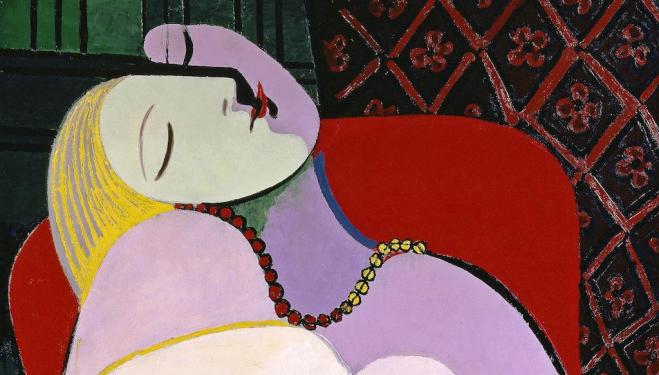
Lorca believes that ‘photography happens to the photographer, and he makes it happen’. Rather than seeking out a window pane that reflects a Mondrian painting, Lorca has carefully manipulated light, cropped the window pane and altered perspective to do so. The curatorial team, however, are keen to stress that this is not a cultural showdown of who did it first or who did it better, but a showcase of simultaneous experimentation and discovery.
The show is not a precisely chronological overview, but as we journey through the galleries we journey through time. We see developments in techniques and technologies meticulously chartered chapter by chapter; it’s as though the twelve galleries become pages of a metaphorical history book. Tracing the evolution of abstraction, we see rooms devoted to texture and surface, form and function, light drawing, Op Art and Kinetic Art, as well as subjectivity, expression and contemporary abstraction today.

Maya Rochat b.1985, A Rock Is A River, 2018, Tate Modern install view.Courtesy Lily Robert and VITRINE, London | Basel © Maya Rochat. Photo: © Tate (Seraphina Neville)
At the heart of the exhibition is a part-reconstruction of the Museum of Modern Art in New York’s landmark photography exhibition, The Sense of Abstraction. Celebrating the best abstract artists of the 1950s, this exhibition displayed works from Man Ray to Edward Weston. At Tate, we see a little-known series of exquisite Man Ray photographs, taken by swinging a Polaroid camera around and around, hung as they were originally hung in 1960, and a number of important works by Aaron Siskind.
In all of the twelve galleries, the exhibition hang is dense and, at times, a little overwhelming. But, just when the going gets tough, there’s a welcome jolt of colour, an unexpected minimalist canvas, or a gilt gold sculpture to break up abstract monotony. A Bridget Riley spot painting in the tenth gallery together with the exhibition’s finale – a multi-media colourful installation by contemporary artist Maya Rochat – stand out for this reason. Thomas Ruff's experimental photograms crafted in a visual darkroom with a 3-D imaging expert seduce the eyes and mind, too. Challenging the limitations of the medium, Ruff set out to manipulate the size, material, colour and transparency of his digital objects. The finished photogram throbs with energy.
It’s a manifesto Tate exhibition, explains exhibition Senior Curator Simon Baker during the morning’s press conference. It’s a chance for Tate, who owes its now ten-year old photography collection to the work of Baker and his team, to re-insert the history of photography into the well-writ narrative of art history.
It's not a patch on Tate's all singing all dancing Modigliani or Picasso exhibitions, but they have done a sterling job.
| What | Review: Shape of Light, Tate Modern, London |
| Where | Tate Modern, Bankside, London, SE1 9TG | MAP |
| Nearest tube | Southwark (underground) |
| When |
02 May 18 – 14 Oct 18, Open until 10pm on Friday and Saturday |
| Price | £16, Concessions £15 |
| Website | Click here for more information |






